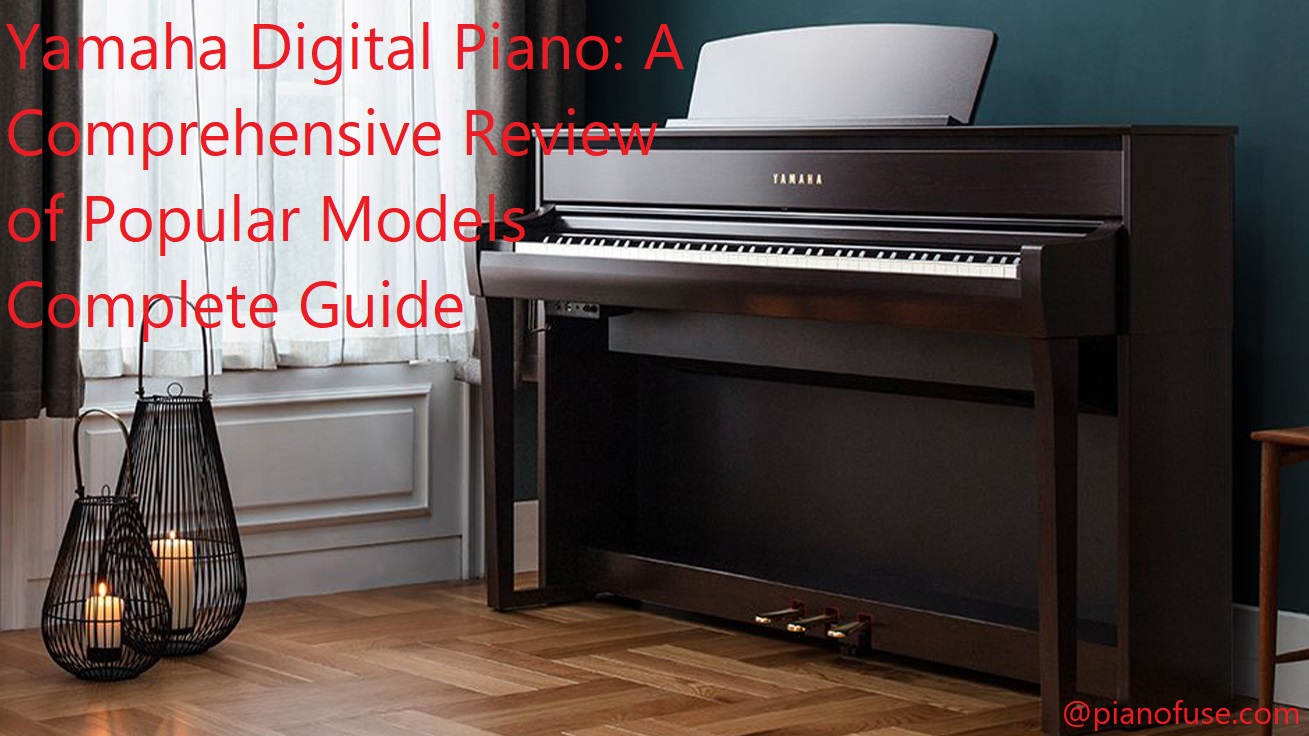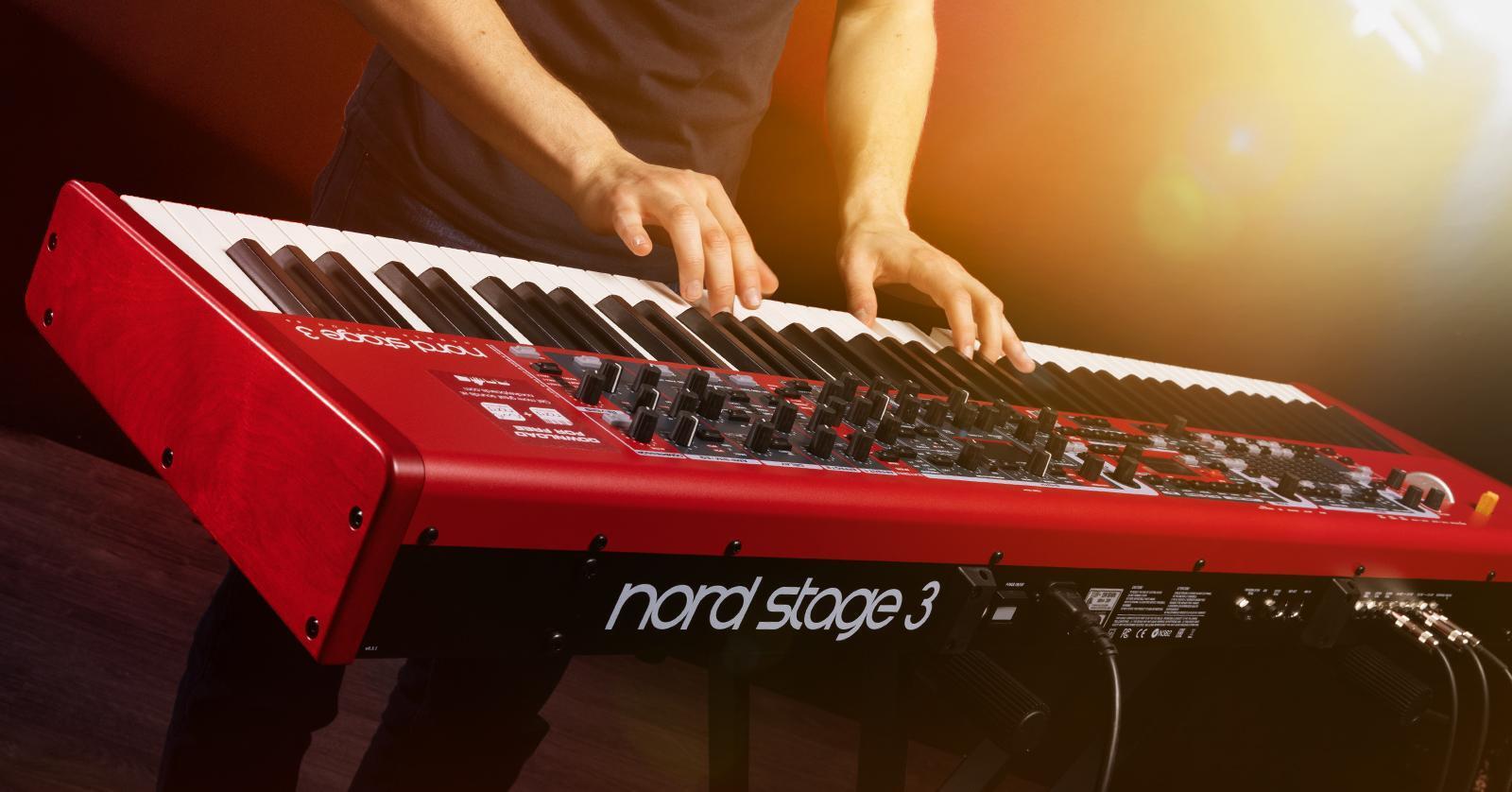Are you looking to buy a digital piano? If so, this guide provides an exclusive review of the most popular Yamaha digital pianos, helping you make the right purchase decision.
With Yamaha’s impressive track record of quality, you can trust that they will deliver an instrument that is tailored to your exact needs and budget.
Yamaha digital pianos offer musicians ranging from beginners to experienced professionals a chance to create authentic-sounding tunes. Yamaha has been producing some of the best digital pianos in the industry since 1887, and they continue to be one of the top-grade names in instrument production.
The Yamaha digital piano lineup consists of several popular models that are designed for various playing needs and skill levels. This comprehensive review provides a quick overview of each model and what kind of features you can expect if you should choose one for your home or studio. We will discuss the range of Yamaha’s offerings within different player messages, its price points, their musical styles, and more.
By reading this article, you will have a better understanding on how to choose the perfect Yamaha digital piano for your needs based on all the information provided here.
Explanation of the topic
A digital piano is the perfect instrument for musicians of any skill level. It offers an unlimited variety of tone, a wide range of musical selection and low maintenance costs without sacrificing performance. With the introduction of Yamaha’s digital pianos, the playing field has opened up significantly — offering you a larger selection than ever before.
This guide will provide you with an in-depth look at the digital piano models available from Yamaha in order to give you a better understanding of what’s available and how each instrument might best suit your needs. We will first examine some common features found on most digital pianos — such as the keys, sound quality and connectivity options — before looking at particular models designed for home use, professional use or beginners starting out. Finally, we’ll discuss what type of Yamaha piano is right for you based on your own needs and preferences.

Importance of a digital piano
The Yamaha Digital Piano is an important tool for aspiring musicians. It provides a wealth of features designed to enhance the playing experience, from weighted keys to built-in speakers. Its sound quality is comparable to that of a real acoustic piano, but with the convenience and portability of a digital instrument.
With these advantages in mind, let’s take a closer look at the incredible range of digital models available from Yamaha.
Yamaha makes several different types of digital pianos. These range from beginner-friendly models equipped with basic features to professional-grade instruments featuring sampling technology that offer an even more realistic playing experience. Discussing the various models in detail gives you an indication of the value each provides for its given price point; this knowledge enables you to make an informed purchasing decision and invest in the Yamaha Digital Piano that best suits your musical needs and preferences.
Features to Consider
When selecting a digital piano, it’s important to consider the features that will shape your playing experience. Depending on what type of player you are, some features may be more desirable than others. Here, we will discuss some of the popular features to consider for Yamaha digital pianos.
Touch Sensitivity: This is an important factor in a successful playing experience as it helps create an organic sound with variations in dynamics. Touch sensitivity allows a player to use more extreme dynamics from softly played notes to loud tones with increased pressure on the keys; this makes a great difference in live performances and recordings.
Voices and Polyphony: Digital pianos come with different voices including grand or electric pianos or organs and strings. Higher-end models have more voices than entry level keyboards and are able to layer different sounds together. Polyphony determines how many notes or layers can be played at one time; higher-end instruments will often have up to 128 note polyphony while some entry-level Yamaha instruments such as the DGX660 offer 64 note polyphony.
Controller Functions: Some models come with controllers that allow you to customize your sound settings so you can tailor it exactly the way you want, giving you options such as changing tone, effects, style and rhythm functions using knobs or buttons allowing for enhanced expressions when playing certain genres like Latin or rock music which require a certain beat and tempo for accompaniment purposes.
Learning Tools: This refers to systems such as lessons integrated into digital models giving you access to practice familiar tunes from easy beginner songs all the way through difficult classical pieces using split screen technology that displays both ‘you’ (the student) and ‘teacher’ side by side for better comparison of both styles simultaneously so students can better adjust their own technique accordingly during their practice sessions – good stuff!
Keyboard
The Yamaha digital piano is one of the most popular brands on the market today, offering a wide range of options to both amateur and professional pianists alike. Depending on your musical needs and skill level, Yamaha provides several different models that suit a variety of budgets. From traditional acoustic pianos to classic digital pianos, Yamaha designs each model with respect to features, price point, and playing styles.
When it comes to keyboards on Yamaha digital pianos, there are three main components: action (the feel of the keys), touch sensitivity (how hard you play affects your sound) and polyphony (the ability to hold multiple notes simultaneously). Each model comes with standard components specific to its product line like weighted action keys for realistic expression of dynamics or USB & MIDI ports for increased connectivity. Regardless of whether you’re looking for an entry level model or an advanced set-up with lots of bells and whistles, there’s a keyboard from Yamaha that suits your needs.
Action
Yamaha digital pianos come with various types of actions. The most common actions found on Yamaha digital pianos are Graded Hammer Standard (GHS) and Graded Hammer Action – GH3.
GHS action offers a lighter touch in the low end of the keys and a heavier touch in the higher end, just like an acoustic piano’s action. GH3 is Yamaha’s next-generation action, offering three distinct levels of touch—light, medium, and heavy—so players can customize their response based on their own personal preferences.
Each key is meticulously weighted to simulate the weight on an acoustic instrument as closely as possible. The feel changes depending on how much force is applied when playing different notes or dynamics, adding to a more realistic keyboard experience while encouraging better practice habits.
Key count
When it comes to digital pianos, the key count is one of the most important factors to consider. It determines the size of the piano’s range and how accurately you can replicate a real piano playing experience. Yamaha offers a diverse selection of digital pianos, each with its own distinct key count. If you plan on playing complex pieces or wish to have access to more notes than what is traditionally possible with acoustic pianos, then a higher number of keys could help you further your musical creativity. When selecting a Yamaha keyboard or digital piano, reviewing these key counts will be beneficial:
76 Keys: The YPG-535 from the Portable Grand Series features 76 semi-weighted dynamic keys with an organic touch and velocity response for an expressive performance.
88 Keys: The P115 from the Purist Series has 88 “graded hammer” standard weighted keys for an incredibly realistic touch and feel when playing dynamic pieces.
61 Keys: The PSRE263 from the Entry-Level Keyboard Series includes 61 full-sized dynamic keys that possess excellent touch response for expressive playability at affordability.
73 Keys: The NP32 Piaggero from the Slim & Lightweight Series comes with 73 dynamic keys that are great for those who need portability yet still want enough expressivity in their performance.
Sound
Yamaha digital pianos are known for their rich sound and wide range of features. Yamaha models range from basic entry-level models to high-end performance concert grands with advanced features and multiple sounds. Sound is a major factor in choosing the perfect Yamaha digital piano, as the sound it produces is key to giving you a realistic experience.
Yamaha’s models use proprietary Digital Grand Expression (DGE) sound, which uses two high-quality stereo samples across a broad dynamic range for an exceptionally rich sound. In addition to this, Yamaha uses Synthetic Resonance Technology (SRT) that mimics the natural acoustic reverberation characteristics of acoustic pianos so you can achieve a deeper and richer musical atmosphere.
More advanced Yamaha digital pianos like the AvantGrand NU1X also feature Virtual Resonance Modeling (VRM), providing incredibly realistic level of resonance generated when notes are sustained on the piano’s keys or pedals. By accurately reproducing damper resonance and simulating string resonance through both harp action and soundboard behavior based on individual notes played, VRM allows you to add life-like vibrato and expressive nuances to your performance.
Finally, Silent Piano allows you to practice late at night without disturbing others while playing an acoustic grand piano thanks to headphones that connect directly to the instrument.
Tone generation
The heart of any digital piano is its tone generation system, which is responsible for creating the rich and complex instrument sounds. Yamaha digital pianos use meticulous sampling technology to capture authentic acoustic piano timbres as well as a variety of other instruments.
Yamaha’s AWM (Advanced Wave Memory) technology creates realistic sounds by digitally recording a wide range of dynamics, both loud and soft. This allows you to play with various levels of expression and nuances that add depth and realism to your performance.
AWM also lets you layer two or more sounds together at once, like placing two different instruments on top of each other for a unique sound experience. You’ll have plenty of control over the relative volume levels, letting you create beautiful harmonies or set up custom sound combinations like guitar and drums for easy accompaniment. With tactile controls ranging from sliders to buttons, Yamaha digital pianos make it easy to adjust your settings quickly.

Polyphony
For the purpose of this Yamaha digital piano review, it’s important to understand what polyphony means. Many digital pianos offer a polyphony feature, which refers to the amount of notes that can be played simultaneously on the keyboard. Polyphony is an important consideration when choosing a digital piano, as certain pieces require complex chords and fast note runs with several keys pressed simultaneously.
The Yamaha models included in this review feature polyphony ranging from 32 to 192 voices, with some models offering even higher levels of polyphony than others. At a minimum of 32-voice polyphony, all Yamaha models provide more than enough range for serious music production and live performances. For beginner players looking to get comfortable playing on their digital piano keyboard, 32-voice polyphony should be more than adequate — though at least 64 voices may be required if you plan on playing complex pieces that involve simultaneous pressing of multiple keys or chords. Professional musicians will want to gravitate towards the higher end models with at least 128 voices of polyphony for creating intricate songs without any crammed sounds or dropped notes, particularly when pairing up two keyboards together for 4-hands playing for performances.
Regardless of your playing style and intended use for your Yamaha digital piano, you can rest assured that you will have plenty of options when it comes to finding a model that offers adequate voice range and sound quality.
Connectivity
The Yamaha digital pianos have a variety of connectivity options to enhance your performance experience. Most Yamaha models feature USB to host compatibility, enabling you to use the instrument as an audio interface with a computer or music production software. USB to device allows you to save recorded audio files directly or transfer song data between the piano and external memory devices like flash drives and external hard disks.
MIDI connectivity enables you to control the piano’s sound using MIDI controllers and use its keys for controlling other instruments via MIDI messages. Additionally, many models also include a 5-pin MIDI port for connecting other Yamaha digital keyboards or electronic musical instruments.
Furthermore, certain newer models also include built-in audio/video inputs for connecting external amplifiers as well as iOS device compatibility for recording and performing music on the go with compatible apps.
Ports
When considering the overall design and usage of Yamaha digital pianos, one of the most important features to consider is the number and types of ports available for connecting external audio devices. For example, a USB-A port can be used to connect a computer or another device, while a set of MIDI ports can often be used to connect additional keyboards in order to create multi-keyboard arrangements or link multiple devices together.
In addition, some models feature traditional headphone jacks as well as Aux out jacks for outputting sound to an external audio system or recording device. Other options may include iPad connectivity ports that allow you to use compatible apps with your keyboard. Depending on your specific usage requirements and what type of devices you plan on connecting, it is important to consider which type of ports are available on each model before making your purchase decision.
Compatibility
When selecting a digital piano, one of the most important factors to consider is its compatibility with other devices. Compatibility means that the piano can be interfaced with other instruments, and whether it works with common music software clients such as Protools and Cubase.
The Yamaha digital piano range has made great strides in the area of compatibility, allowing you to easily connect various hardware and software peripherals. Moreover, all models feature a single USB connection that allows you to directly connect your laptop or tablet for easy recording and composing. Depending on the model, some versions may require an additional power supply unit to power your devices via USB connection.
Furthermore, all models support MIDI IN/OUTPUT connections for sequencing and playback on multiple instruments at once— granting you unprecedented control over creating great music from your Yamaha digital piano.

Conclusion
In conclusion, the Yamaha digital piano offers a range of great choices for the budding musician. Whether you are looking for a piano that is designed for beginners or advanced players, Yamaha has a perfect option for you. Whether you just want to learn to play or take your skills to the next level, Yamaha’s models offer the features and sound quality you need.
Any of these models could be considered a great choice if you are considering purchasing a digital piano. For those who have been playing keyboards and pianos for years there is much to love about this new collection from Yamaha.
FAQ’S
Which Yamaha model piano is best?
Yamaha is one of the most prolific manufacturers of keyboard instruments globally. These are the best Yamaha keyboards and digital pianos right now:
- Yamaha CLP-735.
- Yamaha CP88.
- Yamaha YDP-103.
- Yamaha P-125.
- Yamaha YDP-165.
- Yamaha DGX-670.
- Yamaha NP-12.
Is Yamaha a good digital piano brand?
There is no discussion of the best digital piano manufacturers in the world without Yamaha. They are the most popular, the oldest and have the largest, most versatile range out there. In fact, you have to go back to 1887 to find their first organ, built by Torakusu Yamaha himself.
What is the best Yamaha beginner digital piano?
The Yamaha P-45 is often recommended as a good beginner digital piano from Yamaha due to its affordable price, realistic sound, and weighted keyboard action.
Which digital piano is closest to real piano?
Digital pianos with high-quality sound sampling and realistic hammer action keys, such as the Yamaha Clavinova and the Kawai MP Series, are often considered to be closest to the sound and feel of a real piano.
Is Yamaha better than Casio piano?
Both Yamaha and Casio make good digital pianos, and the quality of their products can vary depending on the model and price range. Ultimately, the choice between Yamaha and Casio often comes down to personal preference and the specific features and functions that you are looking for in a digital piano.
Which piano has the best sound quality?
Acoustic pianos generally have the best sound quality due to the natural sound produced by their strings and soundboard. However, high-end digital pianos from Yamaha, Kawai, and other brands are known for their realistic sound and advanced sound sampling technology.
How long do Yamaha digital pianos last?
Yamaha digital pianos can last for many years with proper care and maintenance. The lifespan of a digital piano can depend on various factors, including the quality of the instrument, the frequency of use, and the maintenance and repair practices.
Which Yamaha is good for beginners?
The Yamaha P-45 is often recommended as a good beginner digital piano from Yamaha due to its affordable price, realistic sound, and weighted keyboard action.
How long do Yamaha pianos last?
The lifespan of a Yamaha piano can depend on various factors, including the type of piano (acoustic or digital), the quality of the instrument, the frequency of use, and the maintenance and repair practices. With proper care and maintenance, a Yamaha piano can last for many years.
Which Yamaha keyboard is best for Indian music?
The PSR-I500 is the ideal keyboard for Indian music lovers.
See Also:
- Best piano mic 2023
- Best portable digital piano 2023
- Best portable piano keyboards 2023
- Best upright piano 2023
- Best yamaha digital piano 2023


